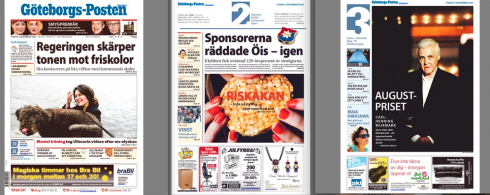The “less may be more” dailies are here

TAKEAWAY: For weekdays, fewer sections may be the answer.
The editor in chief of one of our client newspapers in a large European metropolitan city was asking me yesterday: “Our printing people tell us that it would be easier for us to print our Berliner-format newspaper in TWO sections, instead of three as we currently print. I am not so sure I would like to give up the third section in favor of two heavier ones. What do you think?”
For me, a two-section newspaper may have a greater appeal to a majority of the readers. As busy as everyone appears to be, and with time devoted to newspaper reading decreasing worldwide, particularly Monday through Friday, I am certain that two sections are more palatable, easier to tackle in one or two seatings, and less conducive to that feeling of “guilt” we all succumb to when we cannot get through our daily newspaper. A circulation director once told me that the reason given by many readers of her newspaper when canceling their subscription was the feeling of guilt when evening comes and the newspaper is still sitting there, in its plastic wrapper, unread.
As we tend to do with anything that causes guilt, we simply drop it. Out of sight, out of mind. For example, when I travel outside of the US, I always enjoy reading the two-section USA Today in which the first section combines general news and business; the second section starts with sports and leads to the Life section. Winning combination.
The move towards “fewer section” dailies is nothing new. In fact, the Goteborgs Posten (www.gp.se) in Sweden changed from four daily sections to three tin 1994, with good results. Mixing sports and business, which may have been thought of as totally absurd was done in Goteborg. Strange bedfellows, perhaps, but it worked here.
Per Andersson-Ek, associate editor, was part of the team in charge of making that change in 1994 and tells me what he recalls of how readers reacted:
“It (the change) was quite controversial . In the survey afterwards, some 50 percent said that GP had improved, some 30 percent that they did not like the change.?But, you probably remember the cause of action: To reach new readers, especially females, we added more culture, lifestyle, health, human relations and consumer news, and the women readers liked it.
They told us they thought the new Goteborgs Posten was a more handy, structured and easily navigated newspaper, covering more of today´s topics and talk of the town. They kept telling us :You have created a newspaper for all readers, not just for middle-aged men.”
In Bogota, Colombia, El Tiempo, also moved to consolidate content in 2001, merging content previously appearing in distinctively labeled sections to one book. Today, that is still the way the sections appear.
Coincidentally, last week Sam Zell, chairman and chief executive of Tribune, announced that his firm would trim 500 pages of news each week from the company’s dozen papers, including The Chicago Tribune and The Los Angeles Times. Their aim is a paper with pages – excluding classified advertising and special ad sections – split 50-50 between news content and ads.
In an article June 9 in the International Herald Tribune (http://www.iht.com/articles/2008/06/09/technology/zell.php) the writer posed the question: “ ….is a thinner, flashier, more local newspaper, with a smaller newsroom staff, the best financial model for an industry that is enduring a painful contraction with no end in sight?”
Flashier? Not necessarily. Thinner, yes. I am convinced the newspaper of the next ten years will have fewer pages, published in a more compact format, with much greater coordination between online/print offerings, a more substantial local coverage, and with a design that emphasizes good navigation, clear hierarchy and service.
Fewer pages do not necessarily mean less substance and utility. A more compact newspaper does require more talented editors. That, in the end, may pose a greater challenge than the decision to reduce number of pages.
WHERE IS MARIO? At home in Tampa, Florida this week.
